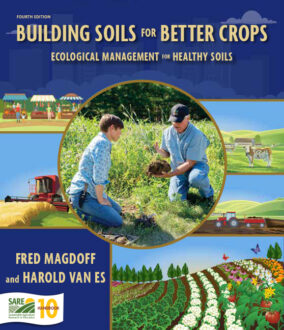There are few farms in this or any country that are not capable of great improvement.
—Lucius D. Davis, 1830
Soil Properties and Their Interrelationships
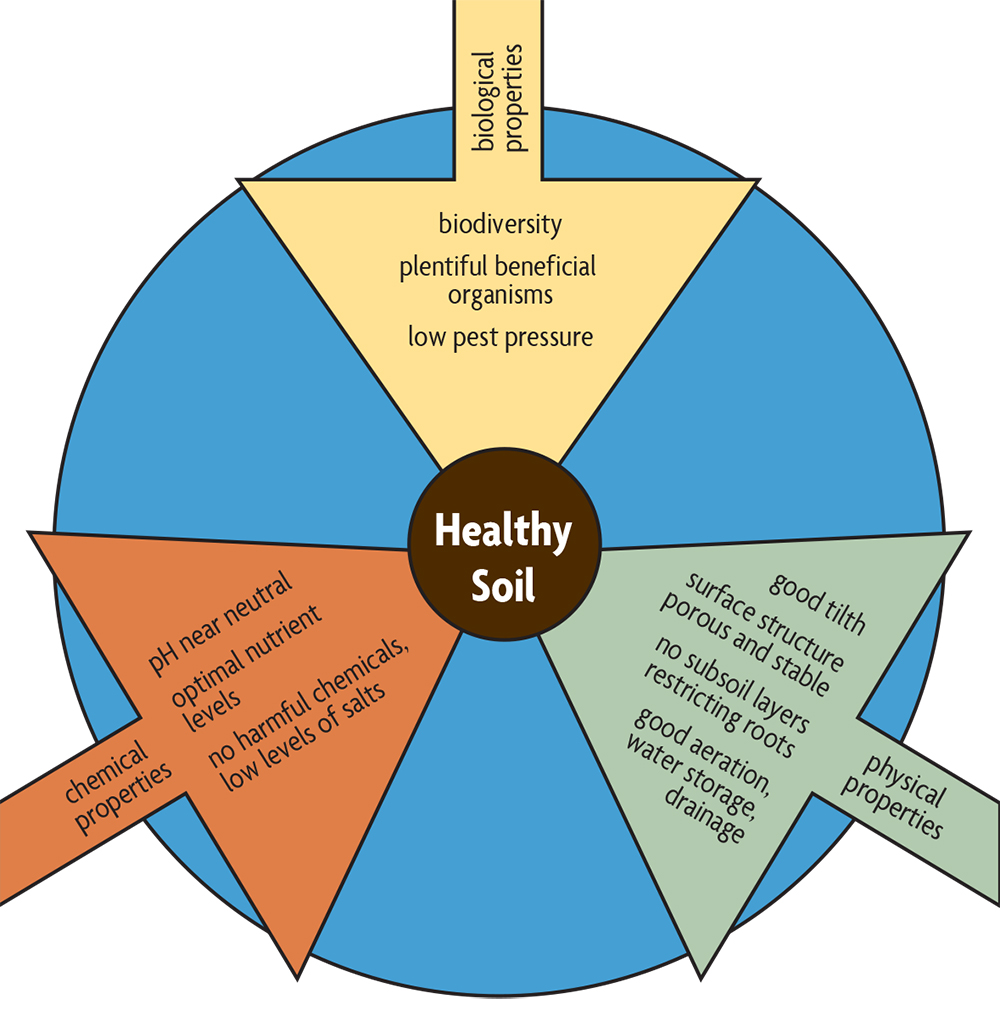
Healthy soils occur when their biological, chemical and physical conditions are all optimal (Figure 8.1), enabling high yields of crops and other important soil functions. When this occurs, roots are able to proliferate easily; plentiful water enters and is stored in the soil; the plant has a sufficient nutrient supply; there are no harmful chemicals in the soil; and beneficial organisms are very active and able to keep potentially harmful ones in check as well as stimulate plant growth.
A soil’s various properties are frequently related to one another, and the interrelationships should be kept in mind. For example, when a soil is compacted, there is a loss of the large pore spaces, making it difficult or impossible for some of the larger soil organisms to move or even survive. (You often don’t find earthworms in compacted soils.) In addition, compaction may make the soil waterlogged, causing chemical changes such as when nitrate (NO3-) is denitrified and lost to the atmosphere as nitrogen gas (N2) and the greenhouse gas N2O. When soils contain a lot of sodium, common in arid and semiarid climates, aggregates may break apart and cause the soils to have few pore spaces for air exchange as well as water drainage into the subsoil. Plants will grow poorly in a soil that has low organic matter content and degraded structure even if it contains an optimum amount of nutrients. Therefore, to prevent problems and develop soil habitat that is optimal for plants, we can’t just focus on one aspect of soil but must approach crop and soil management from a holistic point of view.
Ecological Principles for Agriculture
Approaching agriculture and soil management from an ecological point of view means first understanding the characteristics that comprise resilient and relatively stable natural systems. Then, let’s take a look at overall strategies that can contribute to similar resilience and health of crops, animals and farms. Finally, we’ll briefly discuss practices that contribute to creating vital and strong agricultural systems (discussed in more detail in later chapters).
Managing Soils and Crops to Minimize Pest Problems
It is well established and known by most farmers that crop rotation can decrease many disease, insect, nematode and weed pressures. A few other examples of management practices that reduce crop losses:
- Insect damage can be reduced by avoiding excess inorganic nitrogen levels in soils by using precision nitrogen management.
- Adequate nutrient levels reduce disease incidence. For example, calcium applications have reduced diseases in crops such as wheat, peanuts, soybeans and peppers, while added potassium has reduced the incidence of fungal diseases in crops such as cotton, tomatoes and corn.
- Damage from insects and diseases (such as fungal diseases of roots) can be decreased by lessening soil compaction.
- The severity of root rots and leaf diseases can be reduced with composts that contain low levels of available nitrogen but still have some active organic matter.
- Many pests are kept under control by having to compete for resources or by direct antagonism from other insects (including the beneficials feeding on them). Good quantities of a variety of organic materials help maintain a diverse group of soil organisms.
- Root surfaces are protected from fungal and nematode infection by beneficial mycorrhizal fungi. Most cover crops, especially in reduced tillage systems, help keep mycorrhizal fungi spore counts high and promote higher rates of colonization by the beneficial fungi in the following crop.
- Parasitic fungal and nematode infections can be suppressed by selected cover crops.
- Weed seed numbers are reduced in soils that have high biological activity, with both microorganisms and insects helping the process.
- Weed seed predation by ground beetles is encouraged by reduced tillage and maintenance of surface residues. Reduced tillage also keeps the weed seeds at the soil surface, where they are accessible to predation by other organisms, such as rodents, ants and crickets.
- Residues of some cover crops, such as cereal rye, produce chemicals that reduce weed seed germination.
Ecological crop and soil management practices can be grouped under one or more of three strategies:
- grow healthy plants with strong defense capabilities
- suppress pests
- enhance beneficial organisms
These overall strategies are accomplished by practices that maintain and enhance the habitat both aboveground and belowground. And as the field habitat improves, so does the environment in general: less pollution of groundwater and surface water and more wildlife habitat in and surrounding the field.
Ecological approaches call for designing the field and farm to take advantage of the inherent strengths of natural systems. Most of this is done prior to, and during, planting a crop and has the goal of preventing problems from developing by contributing to one or more of the three overall strategies. In other words, it requires forethought and good planning.
Many natural, relatively undisturbed, systems are generally stable, and when disturbed by natural forces such as fire, wind or excess rain they are able to bounce back fairly rapidly. In other words, they are resilient. These resilient systems tend to have similar general characteristics:
Efficient. Natural systems have energy flows that efficiently use resources. The sun’s energy captured by green plants is used by many organisms, as fungi and bacteria decompose organic residues and are then fed upon by other organisms, which are themselves fed upon by others higher up the food web. Natural ecosystems also tend to be efficient in capturing and using rainfall and in mobilizing and cycling nutrients. This helps to keep the ecosystem from “running down” because of excessive loss of nutrients and at the same time helps maintain the quality of the groundwater and surface waters. Rainfall tends to enter the porous soil, rather than run off, providing water to plants as well as recharge to groundwater, slowly releasing water to streams and rivers.
Diverse. High biological diversity, both aboveground and in the soil, characterizes many resilient natural ecosystems in temperate and tropical regions. It provides nutrients to plants, checks on disease outbreaks, etc. For example, a diversity of plants—trees versus understory, grasses versus legumes—captures and supplies different resources. And competition for resources and specific antagonisms (such as antibiotic production) from the multitude of soil organisms usually keeps soilborne plant pathogens from causing diseases in a natural grassland or forest.
Self-sufficient. A consequence of efficiency and diversity in natural terrestrial ecosystems is that they become mainly self-sufficient, requiring only inputs of sunlight and rainfall.
Self-regulating. The great diversity of organisms decreases the risk of outbreaks (or huge population increases) of pathogens or insects severely damaging plants or animals. In addition, plants have a number of defense mechanisms that help protect them from attack.
These ecological characteristics provide a good framework for sustainable management of fields and farms, but we must also recognize that crop production (and even urban landscaping for that matter) is a process that greatly disturbs natural ecosystems in order to favor one or a few organisms (crop plants) over the competing interests of others. And systems are also disturbed in other ways to be able to produce crops. Routine management practices that occur during the season cause disturbances even if you have invested heavily in preventive management. For example, irrigation is frequently needed for high-value crops such as fresh market vegetables, even in humid regions. Some practices have little direct disturbance, such as scouting for pests and beneficial insects during the season. If an unanticipated problem, such as an insect outbreak, arises, remedial action, such as applying the most ecologically sound pesticide or releasing purchased beneficials into the field, may be required to reduce crop losses.
With currently available pesticides, the temptation exists to simply wipe out competitors—for example through soil fumigation or broad-spectrum herbicides like glyphosate—but this creates dependency on purchased materials from off the farm and weakens the overall resilience of the soil and cropping system. It also promotes genetically induced resistance to these chemicals and makes them less effective in the long run. The goal of ecological crop and soil management is to be proactive and preventive by creating conditions that help grow healthy plants, promote beneficials and suppress pests, and thereby minimize the extent of reactive management (which responds to unanticipated occurrences). The discussion below and in the rest of this book focuses on ways to maintain soil health and to enhance habitat in order to promote one or more of the three strategies listed above.
Ecological Crop and Soil Management
We’ll discuss ecological crop and soil management practices as part of a general framework (Figure 8.2). The heart of the matter is that the strength of the system is enhanced by creating improved habitat both aboveground and in the soil. Although it is somewhat artificial to talk separately about aboveground and the soil habitat—many practices help both at the same time—it makes many issues clearer. Not all of the aboveground discussion refers directly to management of soil, but most does. In addition, the practices we’ll discuss contribute to one or more of the overall strategies: 1) growing healthy plants with strong defense capabilities in healthy soils, 2) suppressing pests, and 3) enhancing beneficial organisms.
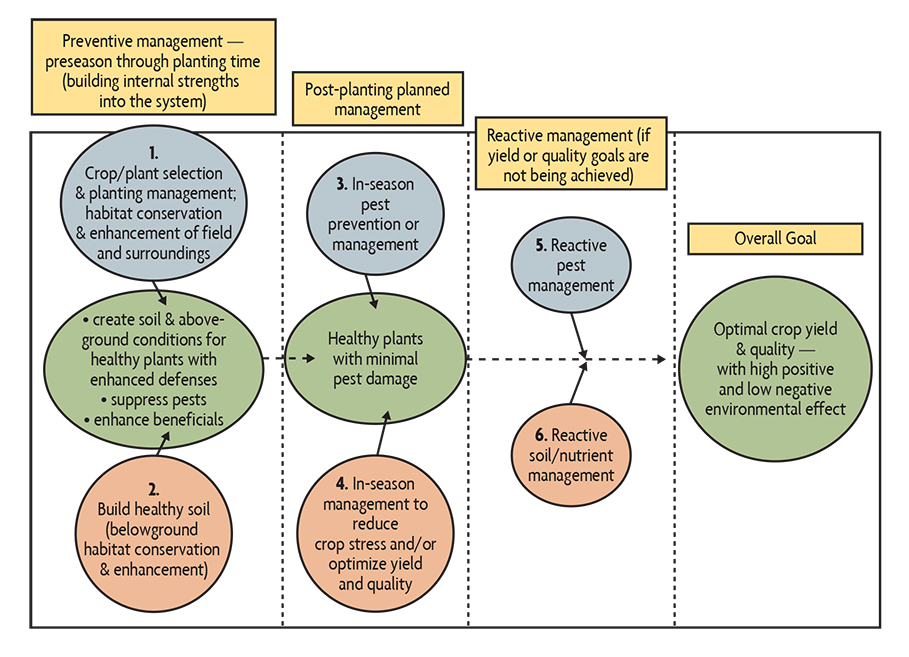
Aboveground Habitat Management
There are numerous ways that the aboveground habitat can be improved:
- Select crops and varieties that are resistant to local pests (in addition to having other qualities such as yield, taste, etc.).
- Use appropriate planting densities (and companion crops) to help crops grow vigorously, smother weeds and (with companion crops) provide some protection against pests. In some cases, use blends of two or more varieties (cultivars) of the same crop. For example, combining one variety that is susceptible to a pest or drought but has a higher yield potential with one that’s resistant and resilient has shown potential for increasing total yields for wheat and rice. Even though the farmer is growing the same crop, increased genetic diversity due to using different varieties seems to provide some protection. Perhaps there are possibilities for intercropping with rows of different crop types such as sunflowers with soybeans or peas.
- Plant perimeter (trap) crops that are more attractive to a particular pest than the economic crop(s) growing in the middle of the field and so can intercept incoming insects. This has been successfully practiced by planting Blue Hubbard squash on the perimeter of summer squash fields to intercept the striped cucumber beetle. The push-pull system practiced in East Africa goes a step further by planting the low-growing legume Desmodium within corn rows as a repellent plant for stem borers (push), and grasses along the field perimeter to attract the adult insect moths (pull), while also providing nitrogen and suppressing weeds.
- Create field boundaries and zones within fields that are attractive to beneficial insects. This usually involves planting a mix of flowering plants around or as strips inside fields to provide shelter and food for beneficials.
- Use cover crops routinely for multiple benefits, such as providing habitat for beneficial insects, adding nitrogen and organic matter to the soil, reducing erosion and enhancing water infiltration into the soil, retaining nutrients in the soil, and much more. It is possible to supply all of the nitrogen to succeeding crops by growing a vigorous winter legume cover crop, such as crimson clover in the southern United States and hairy vetch in the north.
- Use rotations that are complex, involve plants of different families and, if at all possible, include sod crops such as grass/clover hay that remain without soil disturbance for a number of years.
- Reduce tillage. This is an important part of an ecological approach to agriculture. Tillage buries residues, leaving the soil bare and more susceptible to the erosive effects of rainfall, while also breaking up natural soil aggregates. (The use of practices that reduce erosion is critical to sustaining soil productivity.) Some of these practices, such as the use of cover crops and more complex rotations, and reducing tillage, will also be mentioned below under “Enhancing Soil Habitat” and discussed in detail in later chapters.
Belowground Habitat Management
The general practices for improving the soil as a place for crop roots and beneficial organisms are the same for all fields and are the focus of our discussions in the next chapters. The real questions: which ones are best implemented, and how are they implemented in a specific situation (farm or other)? The approaches and practices are discussed in detail in Part 3 of this book, but Table 8.1 summarizes these management approaches and refers the reader to the appropriate chapters. In the final chapter (24) we discuss how all these considerations can be put together into an integrated soil health management approach.
| Ch 12. Integrating Crops and LivestockTable 8.1 Management Goals, Approaches and Practices of Soil Health | |
|---|---|
| OVERALL GOALS grow healthy plants, suppress pests, enhance beneficial organisms, all while improving the surrounding environment | |
| Management Approaches and Practices | Where Discussed |
| Minimize soil disturbance and reduce compaction using reduced tillage, better rotations, controlled field traffic, staying off wet soils, compaction remediation, etc. | Chapters 11 (rotations), 14 (reducing runoff and erosion), 15 (addressing compaction), 16 (reducing tillage), 22 (urban soils) |
| Keep soil covered with crop residue, rotations with perennial forages, and by growing cover crops, which also helps to maintain continual presence of living roots in soil. | Chapters 10 (cover crops), 11 (rotations), 16 (reduced tillage) |
| Maximize biodiversity in soil and aboveground through more complex rotations, frequent cover crops, integrated livestock and crop farming, and applying different types of organic matter amendments such as animal manures and composts. | Chapters 10 (cover crops), 11 (rotations), 12 (livestock-crop integration), 13 (making and using composts) |
| Manage water to promote timely fieldwork and crop needs. | Chapters 14 (reducing runoff and erosion), 15 (preventing and lessening compaction), 17 (irrigation and drainage) |
| Maintain pH within desired range and nutrients at levels that supply plants with sufficient amounts but without excess loss to the environment by routinely testing soils and applying nutrients, lime and other amendments based on results, frequently using cover crops, addressing salt problems, and integrating livestock and crop farming. | Chapters 18 (nutrient management), 19 (managing nitrogen and phosphorus), 20 (nutrients, CEC, alkalinity, and acidity), 21 (soil tests and their interpretation), 23 (use soil health testing) |
A Difficult Pest: Symphylans
Throughout this publication we emphasize the importance to soil health of organic matter and biodiversity, as well as of developing and maintaining good soil structure. However, there is a soilborne arthropod that thrives in soils with good organic matter content and that can cause major damage to a wide variety of crops. Symphylans, which are white and look like a centipede, feed mainly on root hairs and rootlets. They can move around easily with favorable soil structure, lots of old root channels and connecting pores. They occur usually with a spotty, circular distribution within certain parts of fields, and are more of a problem in certain geographic locations. Potatoes and beans appear to be less damaged by the pest, and it has been found that transplanted tomatoes do better than direct seeded ones when symphylans are present. While it is not established that other cover crops help reduce infestations, a spring oat cover crop may lessen damage to a subsequent crop. Increasing the planting density of squash has been shown to help maintain yields in the presence of the pest, though some thinning may be needed. Although some synthetic chemical controls are available, a lot more needs to be learned about how to manage this pest in ecologically sound ways. Care is essential when importing organic amendments: You do not want to introduce this pest by accident. And although there are organisms such as beetles, predatory mites and centipedes as well as fungal pathogens that feed on symphylans, a biologically active soil is not thought to be an adequate defense against this crop-damaging organism.
Conflicting Disease Management Advice?
In this book we promote reduced tillage and retention of crop residues at the soil surface. But farmers are often encouraged to incorporate crop residues because they can harbor disease organisms. Why the conflicting advice? The major difference is in the overall approach to soil and crop management. In a system that involves good rotations, conservation tillage, cover crops, other organic matter additions, etc., the disease pressure is reduced as soil biological diversity is increased, beneficial organisms are encouraged and crop stresses are reduced. In a more traditional system, the susceptibility dynamics are different, and a pathogen is more likely to become dominant, necessitating a reactive approach. A long-term strategy of building soil and plant health should reduce the need to use short-term cures.
Plant Defenses, Management Practices and Pests
After discussing the key ecological principles and approaches to soil management, let’s do a deeper dive and see how amazing plants really are.
They use a variety of systems to defend themselves from attack by insects and disease-causing pathogens. Sometimes they can just outgrow a small pest problem by putting out new root or shoot growth. Many plants also produce chemicals that slow down insect feeding. While not killing the insect, it at least limits the damage. Beneficial organisms that attack and kill insect pests need a variety of sources of nutrition, usually obtained from flowering plants in and around the field. However, when fed upon, by caterpillars for example, many plants produce a sticky, sweet substance from the wounds, called “extra-floral nectar,” which provides some attraction and food for beneficial organisms. Plants under attack by insects also produce airborne (volatile) chemicals that signal to beneficial insects that the specific host it desires is on the plant. The beneficial insect, frequently a small wasp, then hones in on the chemical signal, finds the caterpillar and lays its eggs inside it (Figure 8.3). As the eggs develop, they kill the caterpillar. As one indication of how sophisticated this system is, the wasp that lays its eggs in the tomato hornworm caterpillar injects a virus along with the eggs that deactivates the caterpillar’s immune system. Without the virus, the eggs would not be able to develop and the caterpillar would not die. There is also evidence that plants near those with feeding damage sense the chemicals released by the wounded leaves and start making chemicals to defend themselves even before they are attacked.
Plant Pests
A variety of organisms can harm crops, from pathogens such as viruses, bacteria and fungi to nematodes to insects to weeds. Even larger animals such as deer (or, in Africa, elephants) can significantly damage crops. There is nothing inherently bad about these organisms we commonly call pests. They’re just doing what they naturally do in order to survive and reproduce. But when growing crops we need to minimize the damage done by such organisms. The key is doing so in environmentally sound ways: building healthy soils, using crop varieties with natural resistance, and using rotations and cover crops that suppress pests while providing many other benefits as well.
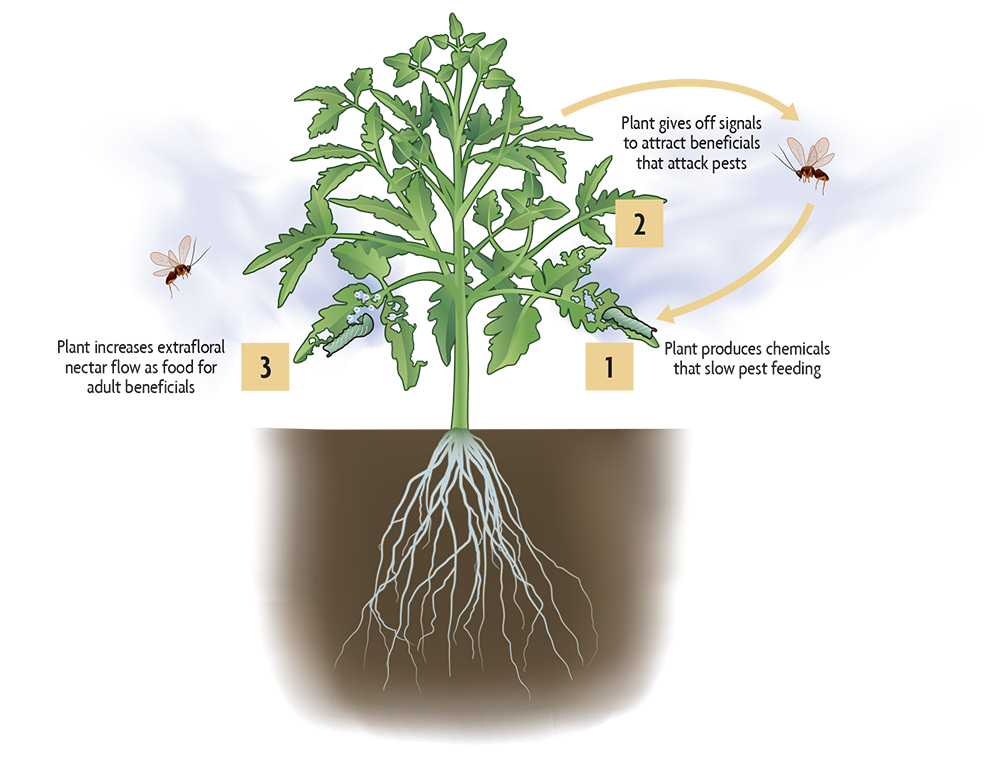
Leaves are not the only part of the plant that can send signals that recruit beneficial organisms when under assault. When attacked by the western corn rootworm, a major pest, the roots of some varieties of corn have been shown to release a chemical that attracts a nematode that infects and kills rootworm larvae. During the process of breeding corn in the United States, this ability to signal the beneficial nematode has apparently been lost. However, it is present in wild relatives and in European corn varieties and is, therefore, available for reintroduction into U.S. corn varieties.
Plants also have defense systems to help protect them from a broad range of viral, fungal and bacterial pathogens. Plants frequently contain substances that inhibit a disease from occurring whether or not the plant is exposed to the disease organism. In addition, antimicrobial substances are produced when genes within the plant are activated by various compounds or organisms—or a pest—in the zone immediately around the root (the rhizosphere) or by a signal from an infection site on a leaf. This phenomenon is called “induced resistance.” This causes the plant to form various hormones and proteins that enhance the plant’s defense system. The resistance is called systemic because the entire plant becomes resistant to a pathogen, even far away from the infection site.
Plants have a number of defense systems that protect them from disease. Beneficial bacteria in soil surrounding the root (the rhizosphere zone) provide a first line of defense against soil-borne diseases by competition or antagonism. If the disease organism (let’s say a fungus like Rhizoctonia solani that causes root diseases in seedlings of diverse crops such as wheat, rice, potatoes, tomatoes and sugarbeets) makes it through the rhizosphere and contacts the root surface, beneficial organisms living inside roots provide another line of defense by producing chemicals that attach the fungus.
Then the plant itself also can produce chemicals that help it resist the attack. There are two major types of induced resistance that are induced in response to signals from microorganisms: systemic acquired resistance (SAR) and induced systemic resistance (ISR) (Figure 8.4). SAR is induced when plants are exposed to a pathogen or even to some organisms that do not produce disease. Once the plant is exposed to the organism, it will produce the hormone salicylic acid and defense proteins that protect the plant from a wide range of pathogens. ISR is induced when plant roots are exposed to specific plant growth, promoting rhizobacteria (PGPR) in the soil. Once the plants are exposed to these, hormones (jasmonate and ethylene) are produced that protect the plants from various pests. Some organic amendments have been shown to induce resistance in plants, and farmers who have very biologically active soils high in organic matter may already be taking advantage of it, as well as of other ways pests are controlled in such soils. However, there currently are no reliable and cost-effective indicators to determine whether a soil amendment or soil is enhancing a plant’s defense mechanisms. More research needs to be conducted before induced resistance becomes a dependable form of pest management on farms. Although the mechanism works very differently from the way the human immune system works, the effects are similar: the system, once it’s stimulated, offers protection from attack by a variety of pathogens and insects.
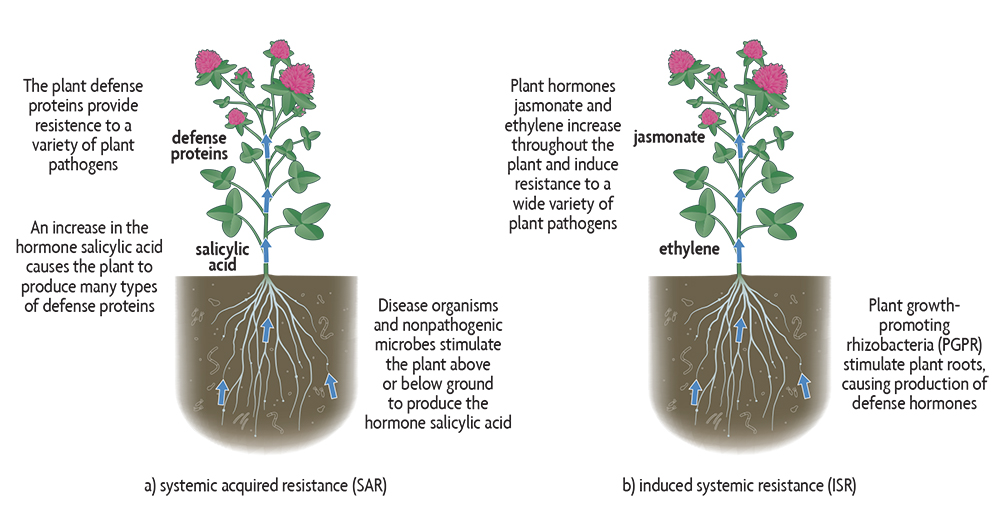
Plant Defense Mechanisms
Plants are not passive in the face of attack by insects, nematodes or diseases caused by fungi and bacteria. Genes activated when plants are attacked or stimulated by organisms produce chemicals that
- slow insect feeding
- attract beneficial organisms
- produce structures that protect uninfected sites from nearby pathogens
- produce chemicals that provide a degree of resistance to pathogenic bacteria, fungi and viruses
- host organisms in roots that protect against pathogens
When plants are healthy and thriving, they are better able to defend themselves from attack and may also be less attractive to pests. When under one or more stresses, such as drought, nutrient limitations or soil compaction, plants may “unwittingly” send out signals to pests saying, in effect, “Come get me, I’m weak.” Vigorous plants, taller and with more extensive root systems, are also better competitors with weeds as they are able to shade them out or just compete well for water and nutrients.
Many soil management practices discussed in this chapter and in the other chapters in Part 3 help to reduce the severity of crop pests. Healthy plants growing in soils with good biological diversity can mount a strong defense against many pests (see text box). Ecological soil and plant management is so critical to plant health because it helps to suppress pest populations and also influences, as we have just seen, the ability of plants to resist pests. Developing optimal soil health is, therefore, the basis for management of crop pests on farms; it should be a central goal that underpins crop integrated pest management (IPM) programs.
Inoculate With Beneficial Organisms?
The practices we discuss later in this part of the book—using cover crops, improving rotations, integrating animals and livestock, using composts and other organic materials, reducing tillage, reducing compaction, and so on—are all aimed at improving the soil’s biological, chemical and physical health. Many of these are the same practices that people refer to when they discuss “biological soil management” or “biological fertility management.” A result of following these practices should be soil rich in biological diversity with highly active organisms. In this soil condition there would usually be little advantage to applying beneficial organisms to seeds or transplant roots. However, even with high biological diversity with active organisms, it is still recommended to inoculate legume seeds with the appropriate nitrogen-fixing rhizobia bacteria. But there is growing interest in the possible use of other microorganisms that might promote plant growth by producing hormone-like chemicals to increase growth, helping plants defend themselves from diseases and insects, helping plants better access water and nutrients, and helping plants through stresses such as drought and wet conditions. A variety of growth-promoting beneficial bacterial and fungal species have been explored, but there are no general recommendations for their use. These types of inoculants may be especially helpful in situations in which plants might be under stress: in soils that are low in organic matter, in soils that tend to be dry and/or have moderate to high salinity, and in fields or plots newly used for farming, especially urban soils. And when transplanting vegetables, it might be worthwhile to dip into solutions containing mycorrhizae if the soil is one in which cover crops weren’t grown that year and, especially, if you’re planting following a brassica (which does not form associations with mycorrhizal fungi).
Chapter 8 Summary
Ecologically sound crop and soil management focuses on combining proactive and reactive management to prevent most factors that might limit plant growth and to address the remaining problems when they occur. The three preventive goals are to grow healthy plants with enhanced defense capabilities, suppress pests and enhance beneficial organisms. There are a variety of practices that contribute to these overall goals and that have been discussed in this chapter as enhancing both aboveground habitat and soil habitat. There is some overlap because cover crops, crop rotations and tillage have effects both aboveground and belowground. The various practices that improve and maintain soil habitats are discussed in detail in the following chapters of Part 3. They contribute to soil building, maintaining soil health by increasing and maintaining the soil’s organic matter, aggregation, waterholding ability and biological diversity.
As indicated in Figure 8.2, in addition to the work of prevention (mainly accomplished before and during planting), there are routine management practices that are carried out during the season, and remedial or reactive approaches may need to be used if prevention practices are not enough to take care of a potential threat to the crop. However, just as with our own health, prevention helps us better deal with the inevitable health challenges because we cannot always rely on a cure after they develop. For this reason, the remaining sections of the book are oriented towards this more-holistic approach with practices that help prevent problems from developing that might limit the growth or quality of plants or harm the surrounding environment.
Chapter 8 Sources
Borrero, C., J. Ordovs, M.I. Trillas and M. Aviles. 2006. Tomato Fusarium wilt suppressiveness. The relationship between the organic plant growth media and their microbial communities as characterised by Biolog. Soil Biology & Biochemistry 38: 1631–1637.
Dixon, R. 2001. Natural products and plant disease resistance. Nature. 411: 843–847.
Gurr, G.M., S.D. Wratten and M.A. Altieri, eds. 2004. Ecological Engineering for Pest Management: Advances in Habitat Management for Arthropods. Comstock Publishing Association, Cornell University Press: Ithaca, NY.
Magdoff, F. 2007. Ecological agriculture: Principles, practices, and constraints. Renewable Agriculture and Food Systems 22(2): 109–117.
Magdoff, F. and R. Weil. 2004. Soil organic matter management strategies. In Soil Organic Matter in Sustainable Agriculture, ed. F. Magdoff and R.R. Weil, pp. 45–65. CRC Press: Boca Raton, FL.
Park, S-W., E. Kaimoyo, D. Kumar, S. Mosher and D.F. Klessig. 2007. Methyl salicylate is a critical mobile signal for plant systemic acquired resistance. Science 318: 313–318.
Rasmann, S., T.G. Kollner, J. Degenhardt, I. Hiltpold, S. Toepfer, U. Kuhlmann, J. Gershenzon and T.C.J. Turlings. 2005. Recruitment of entomopathic nematodes by insect damaged maize roots. Nature 434: 732–737.
Sullivan, P. 2004. Sustainable management of soil-borne plant diseases. ATTRA, http://www.attra.org/attra-pub/PDF/soilborne.pdf.
Tringe, S. 2019. A layered defense against plant pathogens. Science 366 (Nov. 1, 2019, Issue 6465): 568–569.Vallad, G.E. and R.M. Goodman. 2004. Systemic acquired resistance and induced systemic resistance in conventional agriculture. Crop Science 44: 1920–1934.
